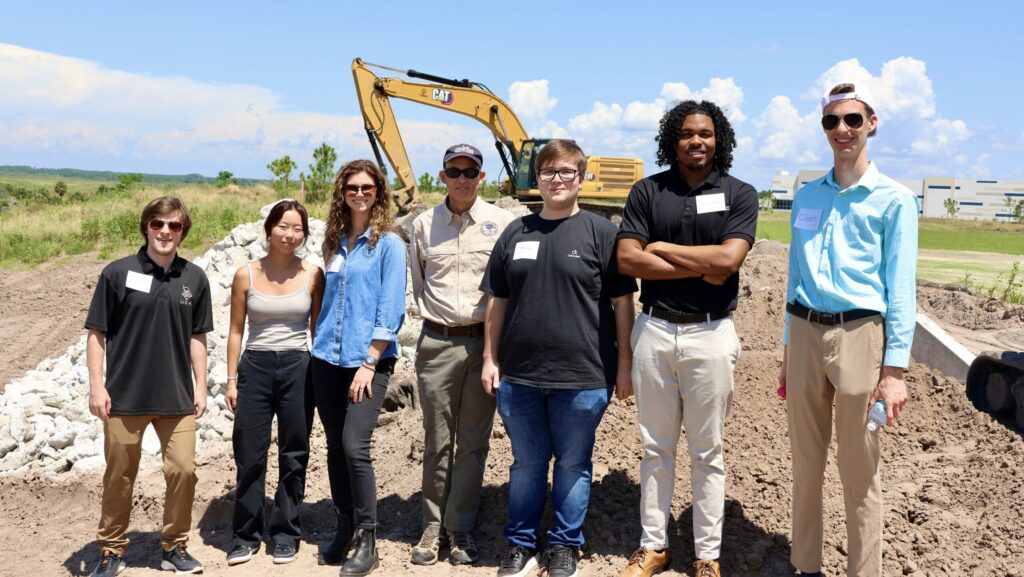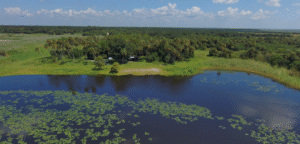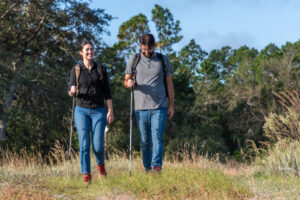
A day in the life: UCF engineering students get a real world look into the District
Five engineering students from the University of Central Florida (UCF) recently traded textbooks for hands-on experience as part of the Knight Shadow Program, spending the day at the St. Johns River Water Management District (District) to see what it’s really like to be an engineer working to protect Florida’s water resources.
The UCF Knight Shadow program is a new way for students to connect with industry professionals and expose them to a wide variety of career paths. Through job shadowing experiences like this one, students gain insight into the “day in the life” of a specific occupation, build their resume, and begin forming networks for future internship and job opportunities.
At the District, the students got a full-circle look at how engineers help protect Florida’s water—from behind-the-scenes permitting to boots-on-the-ground problem-solving.
The day kicked off with an overview of the District and its mission, led by Missy McDermont, the District’s intern program manager. Regulatory Coordinator Marc von Canal played a key role in organizing the day’s agenda in collaboration with regulatory staff, ensuring the students experienced both in-office and field perspectives. From there, the students got a high-level overview of the Environmental Resource Permitting (ERP) program and the Division of Regulatory Services—where engineering, environmental science and customer service all come together.
It wasn’t long before the students sat down with three of the District’s regulatory engineers: Margie Cook, Stacey Leitheiser and David Miracle. They were joined by Cammie Dewey, a former regulatory engineer who now serves as the Middle St. Johns River strategic planning basin coordinator, using her engineering experience to take a more holistic view of regional water management. Each shared personal stories from their careers—how they got started, what they’ve learned along the way and why the work still excites them. For the students, it was a rare opportunity to hear directly from professionals who’ve spent decades protecting water resources in Florida.
Later in the day, the group headed into the field with David Eunice and Grace Clements, members of the District’s regulatory staff—not engineers, but part of the boots-on-the-ground team who assess site conditions and work directly with permittees. At a stormwater pond that experienced a washout after Hurricane Milton, the students got a firsthand look at how something small, like a contractor issue, can quickly turn into a major erosion problem, requiring coordination across departments to resolve.
“It was really eye-opening,” said Sean Peters, one of the UCF students participating in the shadow program. “You learn about these systems in class but seeing how small issues can spiral into big problems, and how a team works together to respond, was probably the most interesting part of the day.”
After the field visit, the students returned to headquarters for lunch and a casual Q&A session with additional engineers. It was a chance to ask honest questions about career paths, workplace culture and how public service fits into the bigger picture of engineering.
Jade Parker, another participating student, said she chose to shadow the District because she wanted to learn more about what water management district does. “I really wanted to get out in the field and see a real-life situation and how engineering knowledge is actually applied to solve a problem,” she said.
McDermont, who coordinated the visit on behalf of the District’s HR team, emphasized the importance of experiences like these. “It’s important to let these students know who we are and what we do. Getting our name out there matters, especially when we’re hiring, and programs like this help students see themselves in these roles,” she said. “We designed this day specifically with engineering students in mind, and I think it really resonated.”
By the end of the day, the students left with a better understanding of what it means to be a regulatory engineer, and how their future careers might make a real impact on the environment and the communities they serve.





